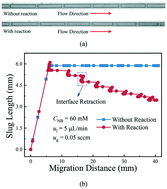Visualization of two-phase reacting flow behavior in a gas–liquid–solid microreactor†
Abstract
The hydrodynamic characteristics of gas–liquid two-phase flow can significantly affect the performance of gas–liquid–solid microreactors. Using nitrobenzene hydrogenation as the reference heterogeneous catalytic reaction, the two-phase reacting flow behavior was visualized and characterized. Distinct differences in the length evolution, migration velocity and residence time of gas slugs were noticed for the reaction and non-reaction cases. The interface retraction of a gas slug was observed, which was mainly due to the hydrogen consumption at the gas pressure accumulation stage. Moreover, effects of the gas and liquid flow rates as well as the inlet nitrobenzene concentration on the two-phase flow behaviors and microreactor performance were also investigated. The results suggested that increasing the gas flow rate could enhance nitrobenzene conversion, but this effect was inhibited by the reduced residence time at high gas flow rates. Higher nitrobenzene concentration could enhance the interface retraction and extend the residence time, and together promote aniline production but in a trade-off with the conversion. This work reveals the intrinsic interaction between two-phase flow behaviors and catalytic reaction in microreactors, which can play a significant role in the development of microreactor technology.

- This article is part of the themed collection: 2019 Reaction Engineering in China


 Please wait while we load your content...
Please wait while we load your content...